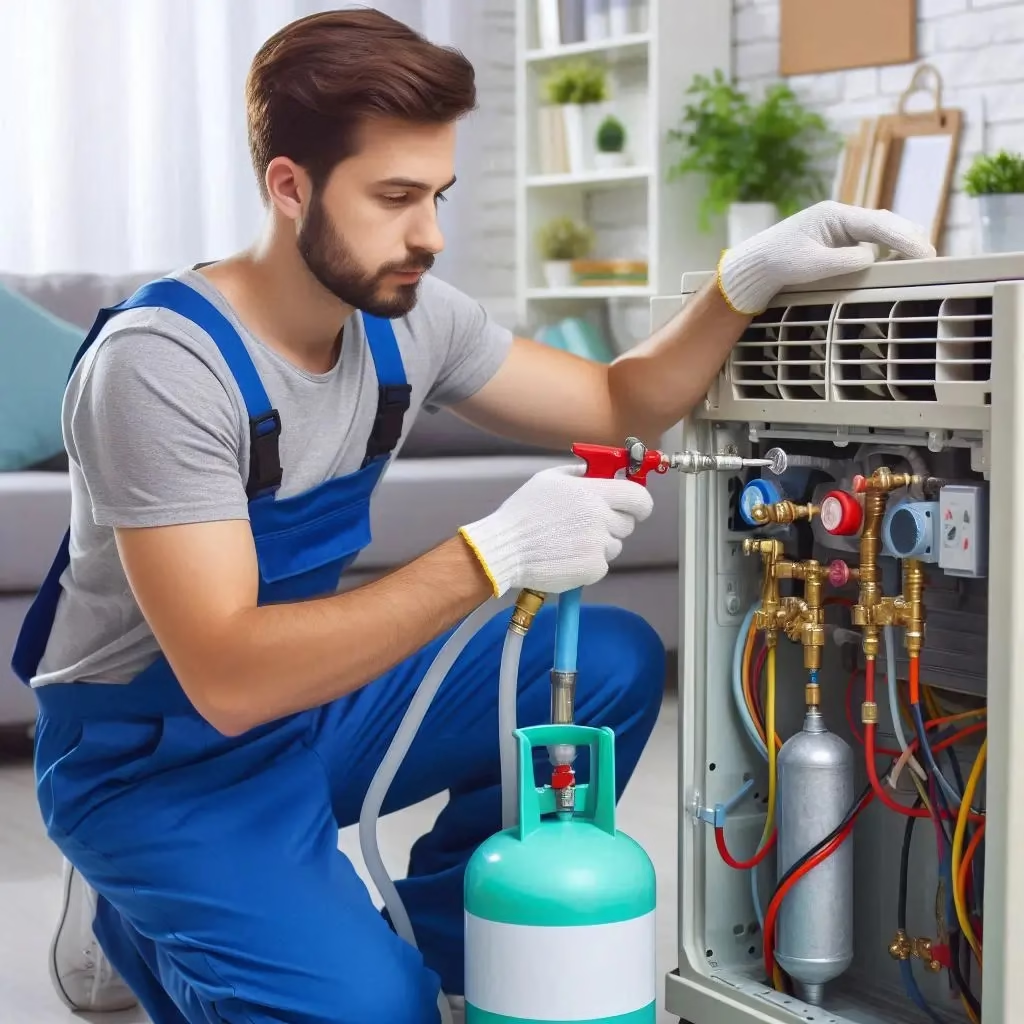Air conditioners (ACs) use refrigerant gases to absorb and release heat, enabling cooling. These gases circulate inside the coils of AC units (like Split AC, Window AC, or Car AC) in a closed-loop system. The most commonly used AC gases (refrigerants) include:
Common AC Gases (Refrigerants)
| Refrigerant | Common Uses | Ozone Depletion Potential (ODP) | Global Warming Potential (GWP) | Remarks |
|---|---|---|---|---|
| R-22 (HCFC) | Older Split/Window ACs | Medium (0.05) | High (~1810) | Being phased out due to ozone harm |
| R-410A (HFC) | Modern Split/Window/Car ACs | 0 (no ozone harm) | Very High (~2088) | Efficient, but high GWP |
| R-32 (HFC) | Newer Split/Window ACs | 0 | Lower (~675) | More eco-friendly than R-410A |
| R-134a (HFC) | Car ACs, refrigerators | 0 | High (~1430) | Common in automotive cooling |
| R-290 (Propane, HC) | Some eco-friendly ACs | 0 | Very Low (~3) | Flammable but eco-friendly |
| R-600a (Isobutane, HC) | Small refrigerators | 0 | Very Low (~3) | Flammable; used in compact systems |
Are AC Gases Harmful?
- To the Environment:
- Yes, some are harmful, especially those with high GWP or ODP.
- R-22 depletes the ozone layer.
- R-410A and R-134a contribute to global warming.
- Newer gases like R-32, R-290, R-600a are more climate-friendly but may be flammable.
- Yes, some are harmful, especially those with high GWP or ODP.
- To Humans:
- In normal operation, AC gases are contained and not harmful.
- Leaks can be dangerous:
- Can cause asphyxiation in confined spaces.
- Some gases (like R-290, R-600a) are flammable.
- May cause frostbite on skin contact due to rapid evaporation.
What Are AC Gases?
AC gases, also called refrigerants, are chemicals used in air conditioning systems to absorb and release heat, enabling cooling. They circulate inside the coils of AC units, transforming from gas to liquid and back again during the refrigeration cycle.
Types of AC Gases
- R-22 (Chlorodifluoromethane)
- Used In: Older Split and Window ACs
- Characteristics: Efficient cooling, but contributes to ozone depletion.
- Phase-Out: Banned in many countries under the Montreal Protocol.
- R-410A (Puron)
- Used In: Modern Split and Window ACs
- Characteristics: More efficient and environmentally friendlier than R-22 (no ozone depletion), but has high global warming potential (GWP).
- R-32 (Difluoromethane)
- Used In: Latest Split ACs
- Characteristics: Low GWP compared to R-410A, better energy efficiency, mildly flammable.
- R-134a (Tetrafluoroethane)
- Used In: Car AC systems
- Characteristics: No ozone depletion potential, but high GWP.
- R-1234yf
- Used In: Newer Car ACs (replacing R-134a)
- Characteristics: Very low GWP, more eco-friendly, mildly flammable.
AC Types and Corresponding Gases
| AC Type | Common Refrigerants Used |
|---|---|
| Split AC | R-22 (old), R-410A, R-32 |
| Window AC | R-22 (old), R-410A |
| Car AC | R-134a (older), R-1234yf (new) |
Are AC Gases Dangerous?
- Health Risks: AC gases are generally safe when sealed inside the system. However, leaks can cause problems:
- R-22 & R-410A: Can displace oxygen, leading to dizziness or asphyxiation in enclosed spaces.
- R-32 & R-1234yf: Mildly flammable, can catch fire under certain conditions.
- Environmental Risks:
- Ozone Layer Damage: R-22 is harmful to the ozone layer.
- Global Warming: R-410A and R-134a have high global warming potential.
Safety Tips
- Always hire certified technicians for AC servicing.
- Ensure proper ventilation if a refrigerant leak is suspected.
- Do not try to recharge or repair refrigerant lines yourself.
Summary:
Modern ACs are shifting toward low-impact refrigerants like R-32 and R-290 to reduce environmental harm. While these gases are generally safe in closed systems, leaks should be addressed promptly by professionals.

